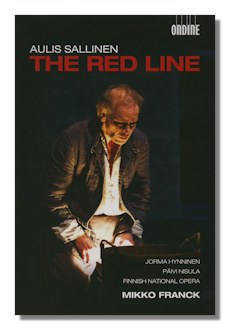
The Internet's Premier Classical Music Source
Related Links
- Sallinen Reviews
- Latest Reviews
- More Reviews
-
By Composer
-
Collections
DVD & Blu-ray
Books
Concert Reviews
Articles/Interviews
Software
Audio
Search Amazon
Recommended Links
Site News
 DVD Review
DVD Review
Aulis Sallinen

The Red Line, Op. 46
- Leena Liimatainen, soprano (Tiina)
- Päivi Nisula, soprano (Riika)
- Anna-Lisa Jakobson, mezzo soprano (Kaisa)
- Aki Alamikkotervo, tenor (Puntarpää)
- Pertti Mäkelä, tenor (vicar)
- Marko Puustinen, baritone (Jussi)
- Hannu Forsberg, bass (Simana Arhippaini)
- Jorma Hynninen, bass (Topi)
- Kai Valtonen, bass (Constable Pirhonen)
Finnish National Opera Chorus
Finnish National Opera Orchestra/Mikko Franck
Tsuumi Dance Company
Pekka Milonoff (stage director)
Interviews with Sallinen, Milonoff, Franck, Hynninen
Ondine DVD ODV4008
Aulis Sallinen's The Red Line (Punainen viiva), the composer's Opus 46, is an opera in two acts from the 1970s; it was first performed by the Finnish National Opera (the company to be heard on this DVD) in Helsinki in 1978. It's set in the winter of 1907 at the time of Finland's first parliamentary election; these were also the years in which Sibelius was celebrating Finish culture from a quietly nationalist point of view. Everyone was eligible to vote for the first time; they did so by drawing a red line on the ballot. In 1909 the author Ilmari Kianto (1874-1970) published a novel of the same name, which examined the dashed proletarian hopes for this election. It is from Kianto's Punainen viiva that Sallinen derived his libretto here.
The composer's main challenge was to deal with the condescending tone of Kianto's writing: for all the author claimed to champion the "common people" about whom he wrote, his attitude, and some of the conclusions about their propensity to be "led", were patronizing and inaccurate. But it was the prevailing sentiment in the 1970s of support for emergent movements for social justice that endorsed the decision of the then Director of the Finnish National Opera, Juhani Raiskinen, to commission this opera from Sallinen.
Sallinen employed some heavy adaptation; he simplified Kianto's text, he added other material of his own and of the original author, and added folk ballads. This – and Sallinen's clear understanding of the tripartite structure of the story revolving around the three climacterics of the bear – sleeping, turning and waking – thrust the perspective away from Kianto's questionable romanticism towards one that was more sympathetic to the subjects of the story; and one that appropriately generalizes their tragedy. By the end of his processes of adaptation and composition, Sallinen was calling Punainen viiva "music theater", rather than opera. And not merely because there is a strong dance element, but also to hint at the work's perceived wider appeal.
But The Red Line keeps its symphonic center of gravity. It's a tonal work with recognizable themes, musical tensions and colorful orchestration. From the tiniest of nuclei, the minor second, D flat/C, most of the opera's leitmotifs derive. There are solo arias, chorus set pieces and conventional sung dialog. This production expertly conducted by Mikko Franck (whom we see arriving into his orchestra at the start: the rest of the DVD is all on stage) achieves a splendid sense of direction and wholeness; there's nothing either over-rhetorical or self-consciously alienating about the integration of words, music and theme.
The staging, set and setting in this DVD are minimal: an indeterminate peasant interior/exterior with dark blues, simple wooden furniture and the clothing of determined, self-aware indigents. Children play a vital and impressive part, though their voices are often evidently those of the yet-to-be-trained. Oddly, there is little sense of the freezing wilderness in northeast Finland in which the action takes place, and which is so prominent an influence on the protagonists' lives.
The principals (especially Päivi Nisula [Riika] and Jorma Hynninen [Topi]) are excellent, convincing, clear and full of animation; there would be a danger to use over-declamatory registers at various points as the tragedy progresses. They avoid it entirely. To be able to follow them visually on this DVD is to respond to their highly-nuanced facial and body language… full of character, interpretative depth and highly communicative understanding of their parts. Hannu Forsberg (Simana) is also devilish and compelling in his delivery.
It's also necessary for both music and staging both to point up – yet not overdo – the symbolism, especially of the red line – as blood, as division, as an unambiguous border over which the poor will not cross (or are not allowed to cross), and finally as a line of Topi's blood. This is achieved totally satisfactorily. Following the action with subtitles (for non-Finnish speakers) and understanding the somewhat Ibsenesque expositions and interchanges between characters who never seem quite to connect, so great are the challenges that separate them, is a moving experience.
One's impression at the end is of a quiet, self-confident drama, not a manifesto – for all the social messages implicit and explicit in the characterization and characters' reflections on their circumstances; chiefly their poverty. In other words, this is an exciting, unadorned, well staged, well sung and performed musical experience to very high production and presentation standards. The recording is aurally and visually top notch, the booklet with the single DVD contains all the requisite information necessary to get the most from the opera; although more background on the singers would have been welcome. As a major milestone in contemporary (Finnish) opera, this is one at the very least to investigate because what all involved have done is produce a concentration on the very essence of the drama, rather than a spectacle.
Copyright © 2011, Mark Sealey.





















